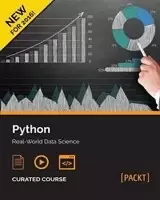
Book Description
Unleash the power of Python and its robust data science capabilities About This Book * Unleash the power of Python 3 objects * Learn to use powerful Python libraries for effective data processing and analysis * Harness the power of Python to analyze data and create insightful predictive models * Unlock deeper insights into machine learning with this vital guide to cutting-edge predictive analytics Who This Book Is For Entry-level analysts who want to enter in the data science world will find this course very useful to get themselves acquainted with Python’s data science capabilities for doing real-world data analysis. What You Will Learn * Install and setup Python * Implement objects in Python by creating classes and defining methods * Get acquainted with NumPy to use it with arrays and array-oriented computing in data analysis * Create effective visualizations for presenting your data using Matplotlib * Process and analyze data using the time series capabilities of pandas * Interact with different kind of database systems, such as file, disk format, Mongo, and Redis * Apply data mining concepts to real-world problems * Compute on big data, including real-time data from the Internet * Explore how to use different machine learning models to ask different questions of your data In Detail The Python: Real-World Data Science course will take you on a journey to become an efficient data science practitioner by thoroughly understanding the key concepts of Python. This learning path is divided into four modules and each module are a mini course in their own right, and as you complete each one, you’ll have gained key skills and be ready for the material in the next module. The course begins with getting your Python fundamentals nailed down. After getting familiar with Python core concepts, it’s time that you dive into the field of data science. In the second module, you’ll learn how to perform data analysis using Python in a practical and example-driven way. The third module will teach you how to design and develop data mining applications using a variety of datasets, starting with basic classification and affinity analysis to more complex data types including text, images, and graphs. Machine learning and predictive analytics have become the most important approaches to uncover data gold mines. In the final module, we’ll discuss the necessary details regarding machine learning concepts, offering intuitive yet informative explanations on how machine learning algorithms work, how to use them, and most importantly, how to avoid the common pitfalls. Style and approach This course includes all the resources that will help you jump into the data science field with Python and learn how to make sense of data. The aim is to create a smooth learning path that will teach you how to get started with powerful Python libraries and perform various data science techniques in depth.
Table of Contents
1. Course Module 1: Python Fundamentals
1. Introduction and First Steps – Take a Deep Breath
2. Object-oriented Design
3. Objects in Python
4. When Objects Are Alike
5. Expecting the Unexpected
6. When to Use Object-oriented Programming
7. Python Data Structures
8. Python Object-oriented Shortcuts
9. Strings and Serialization
10. The Iterator Pattern
11. Python Design Patterns I
12. Python Design Patterns II
13. Testing Object-oriented Programs
14. Concurrency
2. Course Module 2: Data Analysis
1. Introducing Data Analysis and Libraries
2. NumPy Arrays and Vectorized Computation
3. Data Analysis with pandas
4. Data Visualization
5. Time Series
6. Interacting with Databases
7. Data Analysis Application Examples
3. Course Module 3: Data Mining
1. Getting Started with Data Mining
2. Classifying with scikit-learn Estimators
3. Predicting Sports Winners with Decision Trees
4. Recommending Movies Using Affinity Analysis
5. Extracting Features with Transformers
6. Social Media Insight Using Naive Bayes
7. Discovering Accounts to Follow Using Graph Mining
8. Beating CAPTCHAs with Neural Networks
9. Authorship Attribution
10. Clustering News Articles
11. Classifying Objects in Images Using Deep Learning
12. Working with Big Data
13. Next Steps…
4. Course Module 4: Machine Learning
1. Giving Computers the Ability to Learn from Data
2. Training Machine Learning Algorithms for Classification
3. A Tour of Machine Learning Classifiers Using scikit-learn
4. Building Good Training Sets – Data Preprocessing
5. Compressing Data via Dimensionality Reduction
6. Learning Best Practices for Model Evaluation and Hyperparameter Tuning
7. Combining Different Models for Ensemble Learning
8. Predicting Continuous Target Variables with Regression Analysis
A. Reflect and Test Yourself! Answers
B. Bibliography
中文:
书名:Python: Real-World Data Science
释放Python的力量及其强大的数据科学能力关于这本书*释放Python3对象的力量*学习使用强大的Python库进行有效的数据处理和分析*利用Python的力量分析数据并创建有洞察力的预测模型*通过这本对尖端预测分析至关重要的指南,深入了解机器学习。这本书为想要进入数据科学世界的入门级分析师提供这本书,他们会发现本课程非常有用,可以让他们熟悉Python进行实际数据分析的数据科学能力。您将学到什么*安装和设置Python*通过创建类和定义方法来实现对象*熟悉NumPy在数据分析中与数组和面向数组的计算一起使用*使用Matplotlib创建有效的可视化来呈现您的数据*使用PANAS的时间序列功能处理和分析数据*与不同类型的数据库系统交互,如文件、磁盘格式、Mongo和Redis*将数据挖掘概念应用于实际问题*计算大数据包括来自互联网的实时数据*探索如何使用不同的机器学习模型详细地向您的数据提出不同的问题。《Python:真实世界数据科学》课程将带您踏上成为一名高效数据科学实践者的旅程,通过彻底理解Python的关键概念。本学习路径分为四个模块,每个模块本身都是一个迷你课程,当您完成每个模块时,您将获得关键技能,并为下一个模块的材料做好准备。课程一开始就掌握了您的Python基础知识。在熟悉了Python的核心概念之后,是时候深入到数据科学领域了。在第二个模块中,您将学习如何以实用和示例驱动的方式使用Python执行数据分析。第三个模块将教您如何使用各种数据集设计和开发数据挖掘应用程序,从基本分类和对更复杂的数据类型(包括文本、图像和图形)的相似性分析开始。机器学习和预测分析已成为挖掘数据金矿的最重要方法。在最后一个模块中,我们将讨论有关机器学习概念的必要细节,就机器学习算法如何工作、如何使用它们以及最重要的是如何避免常见陷阱提供直观而翔实的解释。风格和方法本课程包括所有资源,将帮助您使用Python跳入数据科学领域,并学习如何理解数据。其目的是创建一条流畅的学习途径,教您如何开始使用功能强大的Python库并深入执行各种数据科学技术。
Table of Contents
1. Course Module 1: Python Fundamentals
1.介绍和第一步–深呼吸
2.面向对象设计
3.Python中的对象
4.当物体相似时
期待意想不到的事情
6. When to Use Object-oriented Programming
7.Python数据结构
8.面向对象的快捷键
9.字符串和序列化
10.迭代器模式
11. Python Design Patterns I
12.Python设计模式II
13.测试面向对象的程序
14. Concurrency
2.课程模块2:数据分析
1. Introducing Data Analysis and Libraries
2. NumPy Arrays and Vectorized Computation
3.对大熊猫的数据分析
4.数据可视化
5. Time Series
6.与数据库交互
7. Data Analysis Application Examples
3.课程模块3:数据挖掘
1.数据挖掘入门
2.使用科学工具包进行分类-学习估计器
3.用决策树预测体育优胜者
4.利用亲和度分析进行电影推荐
5. Extracting Features with Transformers
6. Social Media Insight Using Naive Bayes
7.使用图挖掘发现要关注的客户
8. Beating CAPTCHAs with Neural Networks
9.作者身份归属
10.新闻文章聚类
11.使用深度学习对图像中的对象进行分类
12.使用大数据
13. Next Steps…
4.课程模块4:机器学习
1.赋予计算机从数据中学习的能力
2.用于分类的训练机器学习算法
3.使用SCRICKIT学习机器学习分类器之旅
4.建立良好的训练集–数据预处理
5.通过降维压缩数据
6.学习模型评估和超参数调整的最佳实践
7.整合不同的学习模式
8.用回归分析预测连续目标变量
A. Reflect and Test Yourself! Answers
B. Bibliography
评论前必须登录!
注册